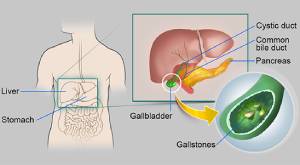Gallbladder Surgery

Surgery to remove the gall bladder is referred to as cholecystectomy. Most frequently performed by keyhole surgery in the abdomen (laparoscopy), the most common indication for the operation is gallstones once they begin to cause symptoms. These stones do not require removal simply because they are present, but symptoms they produce can range from pain, nausea and vomiting right through to bowel obstruction, gangrene and fatal illness. In around 10% of cases, cholecystectomy is required despite the absence of gallstones.
Gall bladder surgery has been routinely performed laparoscopically since 1987. Its advantages over open surgery include reduced incidences of pain, infection, pneumonia, delayed return to normal activity and most complications. Most patients will stay one night in hospital and return to relatively normal activity within one to two weeks. The open operation is now rarely required, perhaps in one in twenty or so cases. These patients usually have longstanding and complicated disease.
Following surgery, patients are advised to reduce the fat content of their diet, which would otherwise be unchanged. Medication is usually required for pain relief from between 2-7 days.
Although the most serious long term complication from gall bladder surgery is a bile duct injury, this is relatively rare. The provision of perioperative antibiotics and measures to prevent both blood clots and chest infection makes most complications now relatively uncommon. Patients are reviewed before discharge home, usually on the following morning, to ensure that any discharge is safe and appropriate.



